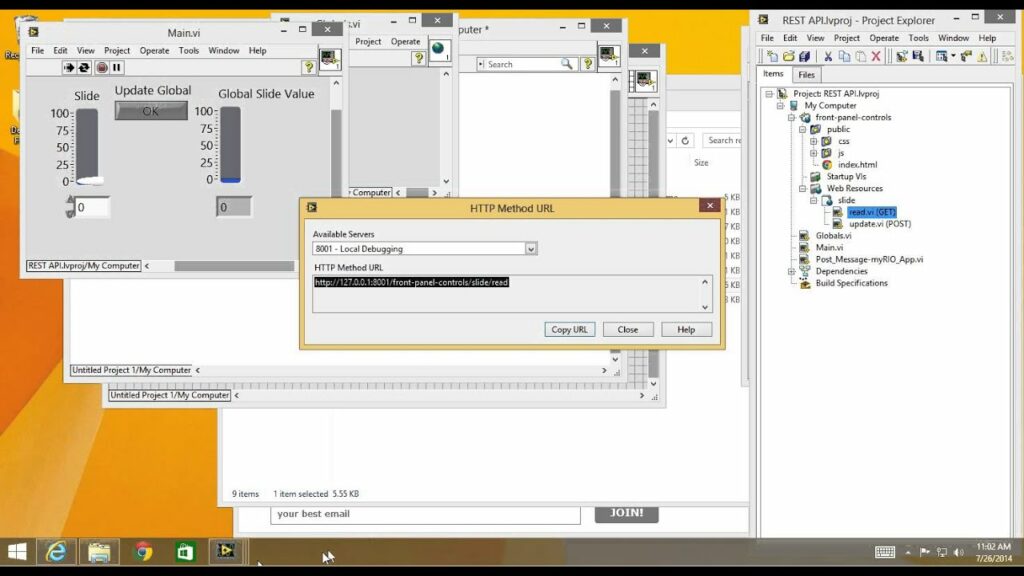Create LabVIEW Web Services and APIs

Creating LabVIEW web services and APIs expands the capabilities of LabVIEW beyond traditional desktop applications, enabling communication with other software systems, web applications, and IoT devices. LabVIEW, developed by National Instruments, is renowned for its graphical programming environment used extensively in data acquisition, control systems, and industrial automation. This comprehensive guide will explore the concepts, techniques, and best practices for creating LabVIEW web services and APIs, empowering you to integrate LabVIEW applications into modern web architectures and leverage their functionalities remotely.
Understanding Web Services and APIs
Web Services
Web services facilitate communication between different software applications over a network (typically the internet). They use standard protocols such as HTTP, SOAP, or REST to enable interoperability between diverse systems and platforms.
APIs (Application Programming Interfaces)
APIs define the methods and protocols through which software components or services can interact with each other. They specify how software components should communicate and function, abstracting complex operations into simpler calls.
Why Create LabVIEW Web Services and APIs?
Integrating LabVIEW with web services and APIs offers several advantages:
- Remote Accessibility: Access LabVIEW functionalities from any location with internet connectivity.
- Cross-Platform Compatibility: Interact with LabVIEW applications from various operating systems and devices.
- Scalability: Scale applications by decoupling frontend and backend operations, allowing parallel development and deployment.
- Integration: Seamlessly integrate LabVIEW with other software systems, databases, or cloud services.
Creating LabVIEW Web Services and APIs
1. Choosing the Web Service Technology
LabVIEW supports different technologies for creating web services and APIs:
- HTTP/RESTful APIs: Use LabVIEW’s built-in HTTP client and server libraries to implement RESTful APIs, leveraging HTTP methods (GET, POST, PUT, DELETE) for data exchange.
- SOAP (Simple Object Access Protocol): Implement SOAP-based web services in LabVIEW using Web Service nodes, which follow the SOAP protocol standards for communication.
- WebSockets: Enable real-time communication between LabVIEW and web clients using WebSockets for bi-directional data exchange.
2. Setting Up LabVIEW for Web Services
Prepare your LabVIEW environment for web service development:
- Install Required Modules: Ensure you have the necessary LabVIEW modules or toolkits installed for web service development (e.g., LabVIEW Web Module).
- Create a New Project: Start a new LabVIEW project or open an existing one to begin integrating web services.
3. Implementing RESTful APIs
Develop RESTful APIs in LabVIEW using HTTP methods:
- HTTP Server: Create an HTTP server in LabVIEW using TCP/IP or HTTP nodes to listen for incoming requests.
- URL Routing: Define URL routes and map them to specific LabVIEW VI (Virtual Instrument) calls for handling HTTP requests.
- Request Handling: Parse incoming HTTP requests, process data, execute LabVIEW code, and generate appropriate HTTP responses.
4. Implementing SOAP Web Services
Set up SOAP web services using LabVIEW’s Web Service nodes:
- WSDL (Web Services Description Language): Define service interfaces and data types using WSDL documents to conform to SOAP standards.
- SOAP Nodes: Use LabVIEW’s SOAP nodes to handle SOAP request messages, process data, and generate SOAP response messages.
5. Implementing WebSockets
Enable real-time communication with WebSockets in LabVIEW:
- WebSockets Server: Implement a WebSockets server in LabVIEW to establish connections with web clients.
- Bi-Directional Communication: Handle incoming WebSocket messages, execute LabVIEW code, and send responses or updates back to connected clients.
6. Securing Web Services
Ensure security measures for your LabVIEW web services and APIs:
- Authentication: Implement user authentication and authorization mechanisms to restrict access to sensitive APIs.
- Encryption: Use HTTPS/SSL protocols for secure data transmission over the internet, protecting sensitive information.
7. Testing and Debugging
Thoroughly test and debug your LabVIEW web services and APIs:
- Unit Testing: Develop unit tests to verify individual API functionalities and ensure reliability.
- Integration Testing: Test integrated systems and components to validate end-to-end functionality and performance.
8. Documenting and Publishing APIs
Document your LabVIEW web services and APIs for developers:
- API Documentation: Provide comprehensive documentation detailing API endpoints, request/response formats, parameters, and examples.
- Publishing APIs: Publish APIs on developer portals or documentation sites to facilitate integration and usage by external developers.
Best Practices for LabVIEW Web Services and APIs
Adopt best practices to optimize performance and maintainability:
- Modular Design: Design APIs with modular architecture for scalability and easier maintenance.
- Error Handling: Implement robust error handling mechanisms to manage exceptions and ensure graceful degradation.
- Versioning: Use versioning to manage API changes and backward compatibility for existing clients.
- Performance Optimization: Optimize API performance through caching, asynchronous operations, and efficient data handling techniques.
Considerations and Challenges
Address challenges and considerations in LabVIEW web service development:
- Performance Overhead: Evaluate performance impacts of web service communication and optimize where necessary.
- Compatibility: Ensure compatibility between LabVIEW versions and web service technologies used.
- Security: Implement security measures to protect against unauthorized access and data breaches.
Advanced Techniques and Integration
Explore advanced techniques for integrating LabVIEW with:
- Database Systems: Connect LabVIEW applications with databases (SQL, NoSQL) using APIs for data retrieval and storage.
- Cloud Services: Integrate LabVIEW with cloud platforms (AWS, Azure) using APIs for data processing, analytics, and IoT applications.
- Mobile Applications: Develop mobile apps that interact with LabVIEW APIs for remote monitoring and control.
Conclusion
Creating LabVIEW web services and APIs extends the functionality and accessibility of LabVIEW applications, enabling seamless integration with modern web architectures and diverse software systems. By following this comprehensive guide and leveraging LabVIEW’s capabilities in web service development, you can empower your applications with remote accessibility, scalability, and integration capabilities. Whether for industrial automation, scientific research, or IoT deployments, LabVIEW web services and APIs provide versatile solutions to meet evolving technological demands and enhance operational efficiencies across various domains of engineering and beyond.




